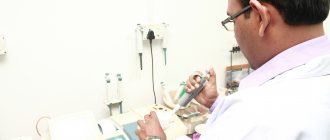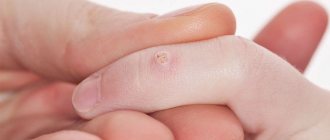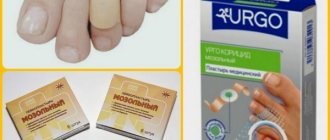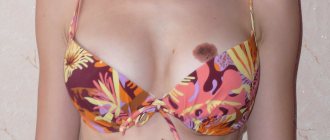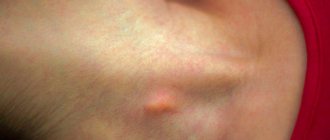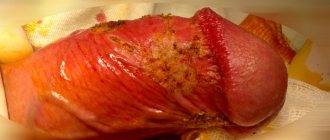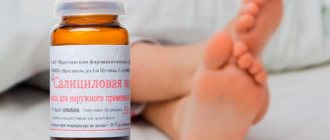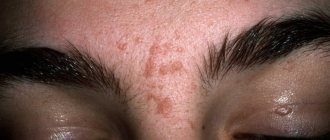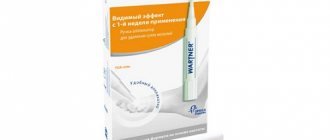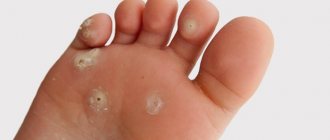It can be difficult to remove benign skin growths at home. The root system of the elements is deeper, larger, and often entwined with nerve endings. The formations on the legs are different from those on the arms - they are larger, denser and hurt when walking. It is possible to get rid of warts on the feet with home remedies if you take precautions to avoid complications.
Description of warts
A plantar wart is a benign epithelial tumor and is a type of common wart. Location on the foot.
The wart is usually uneven in shape with a depression. The surface is rough with a porous structure. The color can be flesh or dark.
When cutting off the top layer, black dots are visible. This disease is also called cornea or spine. On the Internet you can find many photos of plantar warts of different types.
A general idea of the roots of a wart
Almost everyone has seen a wart on the human body, but everyone knows what it is. Externally, it is a large or small growth on the skin, flat or slightly raised, with a rough or smooth surface, similar to a callus.
But hidden inside it are roots (blood vessels), which many are not even aware of. What the root of a wart looks like is shown in the photo.
The roots are located in the trunk of the wart, nourish it and go deep under the skin. Removing them is not easy. You can pull out the growth, but the base with the roots will remain, and soon the same growth will appear again or a scar will remain. You won't be able to snatch it all out in one fell swoop.
Generally speaking, warts are unsightly and uncomfortable, as many of them cause pain, itching and even bleeding.
Their localization can be on any part of the body. Eliminating them is not so easy, so it is better to turn to professionals.
Warts of the plantar type have very deep roots, and the pattern of blood vessels is clearly visible on the surface. This type makes it easy to see what the root of a wart might be. In young growths these are white dots, in old ones they are black. It is difficult to remove them yourself.
Types of warts
All growths differ in size from 1 mm to 2 cm, as well as color. The wart can protrude beyond the surface, be flush with it, or have a small depression.
The tumor can be located on the inside of the foot, on the heel or on the toes. Infection also occurs with more than 100 types of human papillomavirus.
Potent drugs for warts
It is highly not recommended to use such products without a prescription from a dermatologist. They are usually not prescribed for children due to severe pain during treatment.
Solcoderm
One ampoule of Solcoderm solution is enough to get rid of 4-5 warts. Due to the content of acids (nitric, acetic, lactic, oxalic), as well as copper trihydrate, the drug has a mummifying effect and cauterizes papillomas on the legs. Then the growth changes its color - it becomes yellow, brown, gray and disappears.
The drug is suitable for removing even the oldest, largest warts. It is contraindicated for children under 5 years of age and pregnant women. The order of application is as follows:
- Remove the stratum corneum after steaming in water.
- Treat the spine with alcohol.
- Apply the product with an applicator.
- Wait until completely absorbed.
- If after 5 minutes the spine does not change color, reapply the solution.
You can repeat the procedure after a week, but usually one treatment is enough.
Verrucacid
You can quickly get rid of warts with this remedy, which consists of carbolic acid and metacresol. It is available in the form of a solution in a bottle with an applicator. It is used only after consulting a dermatologist, and at home it is applied to the skin with great care!
Before using the product, salicylic ointment is dripped onto the papilloma for 20 minutes, then the leg is steamed in hot water and soda. Next, the top layer is cut off and the medicine is applied. Pins up to 2 mm are lubricated once, larger ones - up to 4 times with 3-minute breaks. Usually, in 2-3 sessions at weekly intervals, even the largest growths can be completely removed.
Super clean
The use of this drug can cause severe pain, so it is prohibited for children, people with sensitive skin, and pregnant women! Contains potassium hydroxide, sodium hydroxide, hydrochloric acid salt. These products, if they come into contact with healthy skin, cause severe burns, so the areas around the spine must be protected with a band-aid or a thick cream.
A single application of the drug after steaming the sole in a volume of 1 drop leads to exfoliation of the skin and the fall of the wart after 3-7 days. Only with deep spines may it be necessary to reapply after a week.
Symptoms
After infection, it can take from several weeks to six months. With the initial signs of the disease, the surface of the growths is smooth, but as they grow, they take on a rough appearance. The wart causes pain and discomfort when walking.
The neoplasm is uneven in shape, often flesh-colored. You can often see dark spots inside the growth from clogged blood vessels. Localization is usually spotty; you can rarely notice several growths nearby.
Complex treatment
Removing the root of a wart involves not only medication or surgery. Experts recommend using complex therapy, which includes taking: antiviral agents, immunomodulators, vitamins, folk tonics, hormonal drugs (for endocrine system disorders).
But do not make decisions on your own; consulting a doctor before starting therapy is a prerequisite.
Causes
Plantar warts appear after infection with the human papillomavirus. It can be transmitted through a handshake and contact with an infected person.
The virus remains in the body for many years and may not manifest itself in any way. HPV is activated as a result of weakened immunity and begins to actively multiply.
Other reasons include:
- wearing tight shoes;
- wounds on the skin of the feet;
- constant stress;
- failure to comply with hygiene rules.
Methods for getting rid of growths and their effectiveness
There is no single treatment process in medical practice. For all types of papillomas and their subtypes, there is a unique technique. There are several types of treatment:
- Freezing with liquid nitrogen. The most popular method of treatment, which guarantees only 50-60% of a favorable outcome. This statistics exists due to frequent relapses among the population.
- Current therapy. The probability percentage varies from 70 to 90, and the possibility of returning to the start of treatment is 40%.
- Removal by radio waves. Mainly used to get rid of genital warts - condylomas.
- Laser removal method. The probability is quite impressive from 55% to 95%.
- Excision under anesthesia using a scalpel. This type does not guarantee complete recovery.
- Treatment with medications: tablets, creams, ointments. Effectiveness cannot be monitored without an accurate picture of the disease.
- Folk remedies.
People at high risk of infection
People in professions such as construction workers, workers in the meat processing and fishing industries are at high risk of infection.
The virus can be acquired by visiting swimming pools and other public places. People with weak immune systems, patients with cancer and AIDS have a high risk of infection.
Color
The color of this benign formation depends on how long ago it appeared and the area of the body where it was found.
On the face, neck, chest, back, in the armpits and skin folds of the body, where the stratum corneum of the skin is moderately developed, the neoplasms do not differ from the surrounding tissues or have a pinkish wart color. Age-related warts acquire a characteristic gray, cracked top made from dead epidermal cells. Over time, the growths can accumulate the pigment melanin, turning them into yellow or light brown warts.
Be wary of excessive pigmentation of the neoplasm . It requires contacting a doctor who treats warts and may be a sign of squamous cell carcinoma, melanoma, or keratoma.
On the skin of the hands, feet and fingers
These areas are subject to constant mechanical stress, so aging of the spine located here occurs much earlier. The once pink skin growth becomes covered with a dry gray or yellow crust, through which “black rods” become visible.
On the genitals
Genital warts are usually numerous small, round, pink bumps. They deservedly receive more attention than formations of other localizations. The doctor carries out a differential diagnosis of warts and condylomas with genital herpes and other sexually transmitted diseases.
The skin around the wart is usually unchanged . If you find swelling, redness or a wound with discharge, consult a specialist. Perhaps the neoplasm is not a harmless spine.
Treatment in medical institutions
The wart must be removed because... it causes discomfort. The procedure is best performed under the supervision of a physician. There are many methods of medical removal:
- Laser removal involves burning off the infected skin surface. The most effective way to combat this disease. There are pros and cons to laser plantar wart removal. The positive aspects include that the wart completely disappears and healing occurs quickly. The disadvantages include the high cost of the operation.
- Cryotherapy involves freezing tissue with liquid nitrogen.
- Surgical intervention consists of mechanical removal of the wart with a scalpel.
- Cauterization with chemicals.
- Radio wave removal allows not only to excise the affected area, but also cauterizes the capillaries.
Not all removal methods are suitable for a child. Only a specialist knows how to remove plantar warts for children. You should not self-medicate; you should immediately consult a doctor.
Removal methods on legs at home
There are two ways to remove warts on the leg: burning and mechanically. The first involves the use of agents with a necrotic or burning effect that kills the cells of the formation. The second is to remove the outgrowth by cutting out the root stem.
Removal using pharmaceutical and folk remedies. The principle of their action is the same - they affect the area of skin with a wart, dry it and after a while make it fall off.
Pharmacy drugs
There are tools and tools designed for the safe removal of growths on the legs according to a doctor’s indications or when used independently.
There are ointments, solutions with a necrotic effect, bottles with liquid nitrogen.
Pharmacy remedies against growths on the legs:
| Name | Description of operating principle | How to use |
| Wartner cryo | A cylinder with liquid nitrogen cooled to a temperature of 190°C. It burns out the formation and after 1-1.5 months a small scar or spot remains in its place, healing over time. | Screw the soft cotton applicator into the rod, then insert it into the bottle and press the cap with a delay of 3-4 seconds. Apply the nitrogen-cooled applicator to the growth for 40-50 seconds, depending on its size. |
| Varrukacid | A liquid solution that burns the wart along with the root. The main component is phenol (alcohol), which simultaneously disinfects the surface of the dermis. | Insert the applicator into the liquid, draw it inside and apply it to the formation, without touching healthy areas of the skin. Do not wet the area during the day. |
| Salipod | Adhesive plaster impregnated with salicylic acid, sulfur and antibacterial substances. Acid irritates the skin, making it keratinized and dead. | Place the center of the patch on the wart and secure the edges tightly so that the adhesive sides do not fall off when moving. If the adhesive plaster is solid, cut out a circle with a diameter the size of the outgrowth and glue it on top with another plaster. |
Warts and papillomas are benign, but appear due to the activity of one of the types of HPV. To suppress the pathogen, use immunomodulatory and antiviral agents - oxolinic ointment, Immunosin, Groprinosin.
Folk remedies
Is it possible to get rid of plantar warts at home? Among folk remedies, celandine and garlic juice, as well as vinegar essence, are recommended. These methods have a chemical effect on the growth and cauterize the affected areas.
Biologically active drugs for warts
Nowadays, pharmacies sell a number of multicomponent drugs for papillomas; they can be used against different types of tumors.
Balm Papillok
Contains potassium hydroxide, sodium hydroxide, carbolic acid, perlite oil. The drug not only burns out growths, but also slows down the division of viruses, preventing the reappearance of the problem. After thoroughly washing the skin, squeeze out 2 drops of balm from the first container and apply evenly to the growth. After 5 minutes, repeat the procedure, taking the skin regeneration drug from the second bottle. You need to use the product for 1-2 weeks until the skin heals.
Sunny Skin
This medicine contains active ingredients - salicylic acid, tea tree oil, castor oil. The product has an antiviral effect, disinfects the skin, and also helps to gradually dissolve the wart with the removal of its keratinized tissue.
After using the drug, there are no scars left, no severe pain during treatment, no contraindications. It should be applied pointwise with an applicator three times a day. Course – 1-2 weeks. During this period, the papillomas dry out, and new ones do not form in their place.
Ointment Stefalin
The ointment contains a number of herbal extracts and oils, the exact set of which is kept secret by the manufacturer. It should be applied to the wart up to 3 times a day for 2 weeks. During this period, the tissues of the formation become necrotic and it disappears. The product does not contain chemicals, so no scars are formed after removal.
Prevention
The most effective way to protect yourself from this disease is to strengthen your immune system.
It is necessary to eat healthy foods, often walk outdoors, exercise and breathe fresh air. If necessary, take medications that strengthen the immune system.
When visiting the pool, use only your own shoes and towel. You should only wear comfortable and warm shoes appropriate for the season. And also avoid long-term stress and worries in life.
Methods for removing wart roots
The most famous and effective method of root removal is laser, which is carried out using special devices. How can you tell if a wart still has a root?
To verify this, it is necessary to conduct an ultrasound examination. Only on the basis of the results obtained is a conclusion made about the effectiveness of the wart treatment and root removal. If necessary, the roots are removed again in the clinic.
How else to get rid of the root of a wart? Using cryotherapy. In this case, the wart is affected by freezing, as a result of which the liquid inside the growth freezes and the tissue ruptures.
However, this method does not guarantee 100% removal of roots and after it, marks in the form of scars and cicatrices may remain on the body. In addition, it is not used to remove warts on the face.
Also, the attending physician may prescribe radio wave excision, electrocoagulation or surgery to remove warts.
Photo of a plantar wart
We also recommend:
What does it look like in cross section?
If you cut the spine in half, you can see a dense cellular mass inside it, lifting the overlying layers of the epidermis upward or growing with its papillae into the deeper layers of the skin. The growth characteristics of a wart are dictated by its location and type of formation:
- regular and flat;
- thread-like and pointed;
- plantar and chicken;
- other viral warts.
The growth of the formation can be exophytic (outward) or endophytic (into the underlying tissue).
The roots of the “endophytic” plantar spine grow inward under pressure from walking, irritating the nerve endings and causing pain. The outward growing roots of an ordinary, flat wart or condyloma give the neoplasm a villous appearance.
Under a microscope
Having looked at what a wart looks like under a microscope (photo below), you can see that its mass is based on intensively dividing cells of the granular layer of the skin . The cells are enveloped in a rich network of dilated blood vessels, forming together the roots through which the wart feeds. If the stratum corneum is damaged, capillaries may rupture , so warts bleed easily.
Let's find out what a wart looks like: photo under a microscope.
Spread of infection
Such warts are usually transmitted through personal contact. Common methods of spread are through common bathing areas. The infection enters the skin if it is damaged - cut, scratched, abraded or ulcerated in any way.
Infection can also occur if there are scratches, damage from nail treatments and shaving. This leads to the spread of the virus and the formation of warts in different parts of the body in the same person.
Treatment of toenails
Causes and types of warts
The growths that cover the skin are the result of infection with a virus. There are more than 100 types of HPV, which contributes to the appearance of warts. The infection enters the human body through skin wounds during contact with a sick person. It is easy to become infected in public places where the virus is transmitted through shared items. The following types of warts are distinguished:
- Vulgar, or simple, growths have a dense structure, a shade close to the color of the skin. Appear on the knees, hands, fingers.
- Flat warts resemble smooth spots with a flat surface that rise slightly above the skin. Usually appear in teenagers.
- Plantar or plantar warts. Their roots penetrate deep into the skin. Outwardly, they resemble hard spots that appear on a person’s feet and cause discomfort while walking. In some cases, the growths protrude strongly above the skin and have a “terry” structure.
- Filiform papillomas visually resemble papillae that grow in length. The color varies from natural to brown, the structure is elastic. These warts have small roots.
- Pointed growths affect the genitals and are distinguished by a conical shape. They can grow quickly, provoking destructive changes in adjacent tissues. When such formations appear, immediate treatment is indicated.
Warts have a characteristic appearance. They are easily differentiated from each other.
The presence of a wart with black roots indicates an old form of the disease. But sometimes this can be a defensive reaction to infection, leading to the spontaneous death of the growth. Blackening of the roots occurs when the treatment is properly selected or when the upper part of the growth is damaged.
